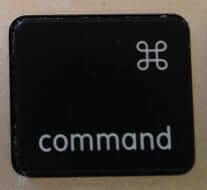

To turn off Sticky Keys, check the Off radio button in the Sticky Keys section of the Universal Access system preferences. If the option to Show Universal Access status in the menu bar is enabled in the Universal Access system preferences, a marquee will appear next to the Universal Access icon in the menu bar stating that Sticky keys is on (Figure 2).įigure 2. Further, an overlay icon will be shown for each modifier key that is pressed.
Mac command key how to#
How To Know That Sticky Keys is Workingīy default, OS X will play a sound when enabling or disabling Sticky Keys and when a modifier key is pressed.

Check the On radio button (circled above) to enable Sticky Keys.
Mac command key mac#
Its function is comparable to Ctrl on a PERSONAL COMPUTER keyboard, but Control on a Mac key pad has its own set of functions, so the two aren’ t. This will allow you to enable or disable Sticky Keys using the shift key rather than via system preferences.įigure 1. The particular Command key is combined with a single letter major for many of the Mac’ s most common activities: Command-C to copy, Command-P to print, Command-V to paste and so forth. If desired, check the box labeled Press the Shift key five times to turn Sticky Keys on or off. (Alternatively, click on the System Preferences icon in the dock.)Ĭheck the radio button labeled On in the Sticky Keys section (Figure 1). Turning On Sticky Keysīy default, Sticky Keys may be turned on in the Universal Access panel of System Preferences:Ĭhose Apple menu > System Preferences, and click Universal Access. This will benefit users who are unable to press or have difficulty pressing shortcut key combinations. Click Add (3).ħ – Change the input selection to Unicode by clicking the Input Selection menu bar button, then chose Unicode.Ĩ – Hold option and type 2318 where you want the command symbol added.Mac OS X Snow Leopard Sticky Keys enables the user to enter key combinations by pressing keys in sequence rather than simultaneously. This adds an input option on the menu bar where you can quickly add symbols.Ĥ – In the same menu, click the + button to add an input source.ĥ – In the search bar (1) type “unicode” and then click Unicode Hex Input (2). Note that steps 1-6 only have to be done once, then step 8 can be completed anytime you need the symbol.ģ – On the Input Sources tab, check the “show input menu in menu bar” box. That said, it is a quick way to add unique symbols if you use them often.
Mac command key code#
This is a little more advanced as you will need to remember or refer to the hex code for the symbol. We’ll cover some of the most basic Mac terminal commands here. Luckily on mac it is very easy to rebind the modifier keys.
Mac command key windows#
Cut, copy, and paste all work as expected, and you can drag any file or folder into the Terminal window to immediately skip to that directory. Control would be control on the mac, alt would be option, and windows would be command. Here is an animation of the process once the menu button has been added: You can open multiple tabs with Command+T or a new Terminal window with Command+N. The Command symbol will be in the list, simply double click on it to insert where desired. Then click done.Ĩ – In the Character Viewer window, click the Technical Symbols tab. It is usually labelled with the Apple logo and a cloverleaf sign. This adds an input option on the menu bar where you can quickly add symbols.ĥ – Click the input menu icon (typically a flag) in the menu bar, then click Show Emoji & Symbols.Ħ – In the window, click the Gear button then Customize list.ħ – Scroll down under Symbols to “Technical Symbols” and check the box. The Apple key, also known as the Command key is a key available on every Mac keyboard. Note that steps 1-7 only have to be done once, then step 8 can be completed anytime you need the symbol.ġ – Go to the Apple menu, then System Preferences.ģ – On the Keyboard tab, click “show keyboard and emoji viewers in menu bar”Ĥ – On the Input Sources tab, check the “show input menu in menu bar” box. This is a relatively easy option, especially if you think you'll want to insert this symbol on even an occasional basis. ⌘ Option 2: Using Show Emoji & Symbols viewer Just highlight the symbol and paste it where you need it! The most simple way to accomplish this task – especially if you only need it once in a while. Here are three ways to accomplish this task: Apple didn't make adding this symbol super simple or intuitive, but each of the following methods will work and continue to work, depending on your needs. It doesn't happen often (unless you're a technical writer), but sometimes you need to write a how to article and reference the command symbol as one of the buttons in a key combination.


 0 kommentar(er)
0 kommentar(er)
